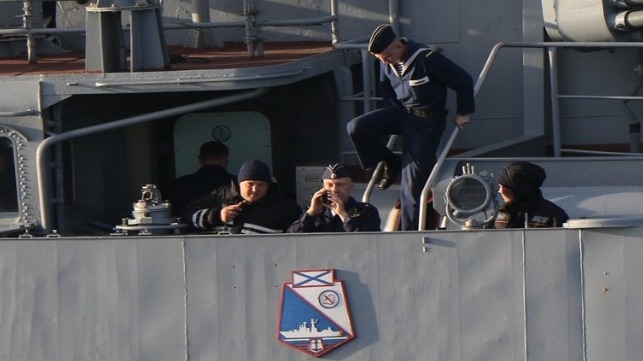Russia Claims to Have Chased U.S. Navy Out of Pacific Exercise Area

The U.S. Navy is pushing back on Russian claims that the destroyer USS Chafee was ejected from the area of a recent Russian-Chinese joint naval exercise.
On Friday, Russia's Ministry of Defense claimed that a Russian destroyer forced the Chafee to alter course after Chafee attempted to "violate the state border of the Russian Federation in the Peter the Great Bay." When the Russian Navy challenged Chafee's movements "in an area closed to navigation due to exercises with the use of artillery weapons," the Chafee raised colors for aviation operations, according to the ministry. After a warning, the Russian destroyer Admiral Tributs approached Chafee to within 60 meters and successfully "stopped [her] attempt to violate the state border," according to the ministry.
"After becoming convinced of the Russian warship’s resolve to prevent the violation of the state border, the guided missile destroyer Chafee reversed its course at 5:50 p.m.," the ministry said in a statement.
In a response, the U.S. Navy asserted that the run-in occurred differently. USS Chafee was in international waters in the Sea of Japan, according to the Navy, and was preparing for flight ops when a Russian destroyer approached. No Russian military exercise notices were in effect at that time for the area, and Chafee "conducted operations in accordance with international law and custom," the Navy said.
Though the Russian destroyer approached to within about 65 yards - a clear close-quarters situation - the Navy said that "the interaction was safe and professional."
The incident occurred in the middle of a four-day joint exercise for Russian and Chinese naval forces. The exercise involved mine countermeasures; joint tactical maneuvering; artillery fire at mock targets, including a towed "surface combatant" target; and air defense operations.
In addition to the Admiral Tributs, the exercise involved the the large anti-submarine destroyer Admiral Panteleev; the corvettes Aldar Tsydenzhapov and Gromkiy; two minesweepers; and the improved Kilo-class sub Ust- Bolsheretsk. The PLA Navy was represented by the destroyers Kun Ming and Nan Chang; the corvettes Bin Zhou and Liu Zhou; and one diesel-electric submarine.
Previous run-ins with Russian forces
The destroyer USS John S. McCain had a similar run-in with Russian Navy forces in the Sea of Japan last year. When the McCain conducted a freedom of navigation operation (FONOP) near Peter the Great Bay on November 24, 2020, the Russian anti-submarine destroyer Admiral Vinogradov responded to the scene and warned McCain to depart "Russia's territorial waters." After the Vinogradov threatened to ram McCain and altered her course, McCain departed, the Russian Defense Ministry asserted.
The U.S. Navy denied this claim. "USS John S. McCain was not ‘expelled’ from any nation’s territory. McCain conducted this FONOP in accordance with international law and continued to conduct normal operations in international waters," the service said in a response.
The Royal Navy destroyer HMS Defender had a similar encounter with Russian forces off Crimea in June 2021. Using a charted traffic separation scheme, Defender passed close by Russian-occupied Sebastopol during a transit between ports in the Black Sea. Her route prompted an angry response from the Russian Defense Ministry, which claimed that an Su-24M fighter dropped four bombs "on the course" of the vessel to force her to depart. The Royal Navy denied that any shots were fired or bombs were dropped nearby, except for a previously-scheduled Russian gunnery exercise some distance away.
